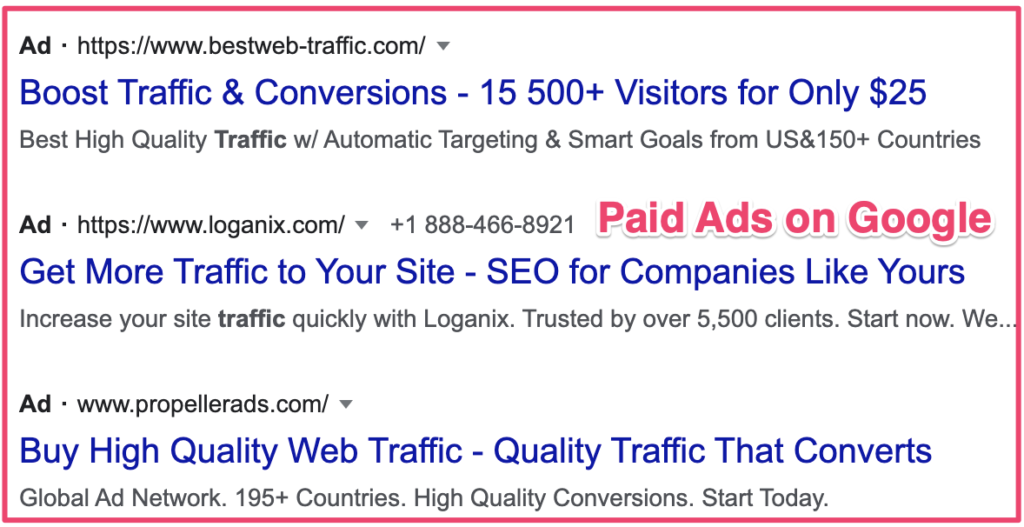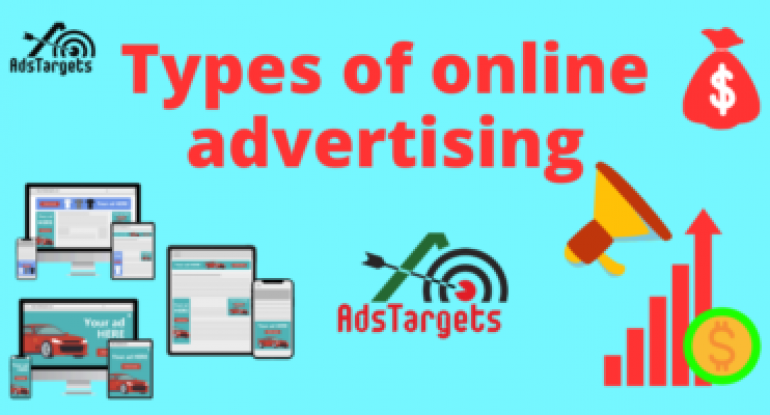There are several types of online advertising used by online businesses to grow their brands, increase their online visibility, and increase their revenue and profits.
Online businesses in almost all industries utilize various types of online ads, however, not all ad type goes with every business or brand. This means figuring which type of advertising may work for your particular campaign.
So which type is actually good for your business? In this post, we will discuss various forms of online advertising available for you to take advantage of and grow your business.
It’s always better to take some time and do some homework before launching your ad campaign to achieve better results.
So, in essence, it will be great if you can also take advantage of online advertising to grow your small or medium scare business to a large multinational company.
So, let’s look at those various types of online advertising…
Table of Contents
ToggleTypes Of Online Advertising
There are many types of online advertising used by brands to grow their businesses. However, you can be able to run paid advertising and free advertising online.
These two forms of advertising will be briefly discussed before taking a detailed look at the main types of online advertising.
Paid Advertising
Paid advertising is the type of online advertising brands, or online businesses pay to get their ads shown or displayed on third-party publishers’ websites, search engines, email platforms, or social media websites.
An example of these ads are ads we see on Google search engines, within our email accounts such as Gmail or Yahoo mail and so social media websites such as Facebook Ads, Instagram ads, on blogs such as AdsTargets ads.
Free online advertising
Free online advertising is not paid for but sometimes can be as popular as paid ads.
These ads are more popular on social media websites, online forums, and popular blog posts, and other viral social media posts.
Now let’s take a look at some types of online advertising.
#1. Display Ads
These are very famous ads used by many marketers across all industries to target audiences online.
These come in form of banners ads, text ads, eCommerce product ads, Interstitial ads, videos ads, Pop ups, and many more seen on desktop and mobile devices.
Though YouTube is also regarded as a search engine, display ads are displayed on it and email platforms like Gmail and Yahoomail.
Display advertising is mostly found on blogs, websites. Most marketers use display ads for retargeting clients that previously visited their website using data collected by pixels or cookies.
 |  |
#2. Native Advertising
Native advertising is also categorized as display advertising. However, it comes in the form of recommended content that is displayed within or at the end of articles as recommended read or sponsored content.
Native advertising is a very effective way of advertising your business. There are numerous reasons you should consider running native ads. These ads are less intrusive and loved by both publishers and their visitors.
Good imagery makes native ads very attractive for website visitors hence interacting with these ads more than some other display ads.
#3. Video advertising
Video advertising is very popular on YouTube, AdsTargets, Facebook, Instagram, and TikTok and has been growing so fast over the past few years. Videos are displayed at the beginning, middle, and end of the videos to get the target audience’s attention.
It’s a great way to tell a brand story and has proved to be very effective. At Adstargets, we offer video ads to enable you to reach your customers using VAST and HTML5 Video Ads based on the cost per view (CPV) pricing model.
Our video advertising is optimized and responsive to fit all desktop and mobile devices.

Our video advertising offers advertisers the opportunity to showcase their products and services and most importantly, to use Adstargets Video Ads to tell their brand story to a large audience locally and globally.
Our video ad platform supports VAST tags for both linear and non-linear ads.
These video ad formats are customizable to suit linear Ads, which can be pre-roll (before the original video), mid-roll (in between the original video), or post-roll (after the original video). Non-linear Ads (requires player support) can be text or banners.
#4. Interstitial advertising
Interstitial ads are also known as full-page ads is another form of display ad that usually appears on webpages and mobile devices while the user is on the page, or while the page is loading, or when the user is about to leave the page.
At AdsTargets, we offer these ads to help increase the conversion rate for brands and marketers.

You are welcome to use those valuable spare moments in between web pages to reach your audience with an immersive advertising experience.
Our Interstitial ads are cost-effective as a format for the advertiser as it gives maximum exposure even with little investment.
#5. Mobile Advertising
Mobile advertising is typically advertising campaigns aimed at targeting mobile users. Why? The use of mobile devices has surpassed internet desktop internet use since 2014.

Since then it has made mobile ads very popular, especially in regions where most people use mobile devices to access the internet.
Mobile ads have the potentials to take your business to the next level as an advertiser. Most of your potential clients spend most of their time on mobile devices each day.
Our mobile is designed to take your ads to your potential clients anywhere and at any moment to increase brand reach and visibility.
Please take advantage of our mobile advertising display campaigns to reach your audience with cost-effective campaigns.
#6. Search engine marketing (SEM)
Search engine marketing or SEM is a marketing strategy aimed at increasing website visibility in search engines through search engine report pages (SERPs)
Advertisers bid for keywords to be able to appear on search engines such as Google or Bing when someone searches for keyphrases that match their search terms, which gives the advertiser ads to appear alongside search results for particular search queries.


These ads are often known as pay-per-click ads which come in a variety of ad formats.
Some are small, text-based ads, Others, such as product listing ads (PLAs, also known as Shopping ads), are more visual, product-based advertisements that allow consumers to see important information at-a-glance, price, and reviews.
Search engine marketing also involves Search engine optimization (SEO), which is different from paid search engine marketing, where the advertiser pays to show their products or services on SERPs.
In the case of SEO, The results are displayed based on the credibility of the content for free.


Retargeting Advertising
Retargeting, also called remarketing, is a way of showing ads to a specific audience that previously initiated actions or visited your website through your previous ad campaigns.


Ad networks let you collect data on your target audience to remarket to them or create more display ads to show to them to get them to come back to your website and complete the actions they initiated.
Retargeting or remarketing is an important aspect of online advertising and is known to enhance ad performance by increasing conversion rates.
Here at AdsTargets, we have retargeting opportunity to allow our advertisers to retarget their audience and increase their ad performance.
Advertising Pricing models
PPC Advertising
I believe you have seen or heard of this term already. “PPC advertising“. it’s prevalent among online marketers and brands. PPC stands for Pay per click.
It’s basically paying for each click you get from your ad campaign. For example. During your ad campaigns on Google Ads, you are charged for each click you get during the entire ad campaign.
Thus each time someone clicks on your ad, you are charged based on the cost you set or per bid rate.
This is a prevalent advertising price model used by many ad networks to charge advertisers on their platforms. Apart from PPC advertising, there is CPM advertising which will be discussed next.
CPM Advertising
CPM is a pricing model that stands for cost per 1,000 mille or cost per 1,000 impressions received by an advertiser during a campaign. For example, the advertiser is charged a certain amount per 1,000 views or 1,000 impressions.
Instead of being charged $0.5 per click for a PPC campaign, you are charged $5 per 1,000 impressions or views your ads received.
The price varies depending on the bid rate or the advertiser’s price or the ad network for a particular ad campaign.
CPA Advertising
CPA means cost per action (CPA), representing a unit price an advertiser pays for a particular action during an ad campaign.
Unlike PPC and CPM pricing models, the advertiser is charged only if a certain action is completed. For example, when a customer signs up for a program, make a purchase, complete a form etc.
This is also known as cost per activation.
This is a cost-effective form of paying for ads, especially when running lead campaigns or promoting affiliate programs to earn a commission for yourself.
Cost per install (CPI)
Cost per install stands for the cost an advertiser is charged per one installation. For example, Mr X is charged $1 each time a client install his app during an ad campaign at AdsTargets.
It’s mostly used for App install campaigns, extensions and software etc. The CPI pricing model is most effective if you are running campaigns that are aimed at getting people to install software, apps and browser extensions.
These are some of the business advertising models you will have to use.
Online Advertising Agency
Now you pretty much know which types of online advertising you may likely use, the next question will be which online advertising websites or advertising agency to use.
For this, you won’t need to search further. All the types of online advertising formats and pricing models discussed here are found on our ad formats page and you can conveniently and efficiently run your ad campaigns with AdsTargets.
We are pushing hard to provide a platform that offers the most cost-effective and result-driven for our advertisers across all industries.
It’s easy to join AdsTargets and start your ad campaign. We also offer a signup bonus of $20 to $100 bonus depending on your initial deposit. Join us and start advertising today.
Not to be selfish, in case you have tried bing ads, and AdsTargets ads, let us know in the comment section.
Conclusion
Though not all types of online advertising are covered here in this article, you pretty much get a sense of most of the ads used for business advertising.
It’s a matter of research to figure out which platform your target audience spends more of their time on to decide which type of ad campaigns to run.
In any case, we strongly encourage you to try our ad network and have your say. Compare your results with other ad networks to make conclusions.
You are also welcome to recommend which ad type you believe is the most effective and why in the comment section.










6 Responses
Thanks for sharing this amazing piece of content. This one is really helpful.
We are very happy you find this helpful. We are always glad to help and we do it through our blog posts. You are always welcome to read and share with your circle.
Thanks for sharing good information.
You are always welcome
Great read regarding the various types of online advertising and their benefits for continued business success. Thanks for this.
Hello,
We appreciate you for reading. You are always welcome here.